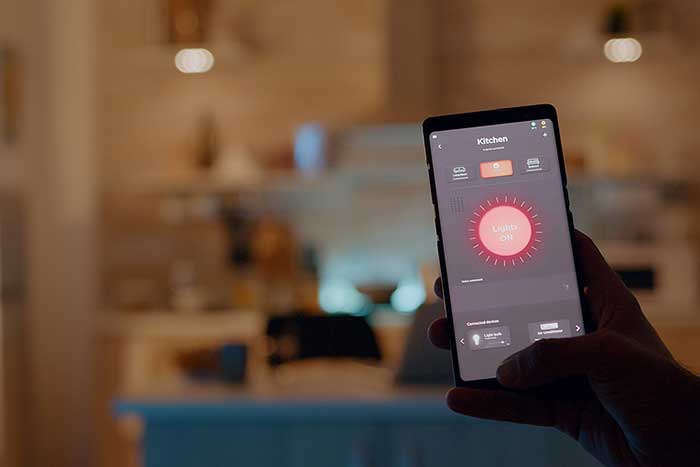Technological innovations continuously impact our lives for the better. Every innovation is a further improvement in the way we handle our day-to-day operations. Furthermore, automation has helped us minimize the efforts that we put in when performing routine tasks.

The improvements in our homes and offices are of great importance through smart building lighting systems that integrate IoT devices. As a result, we attain high-efficiency LED lighting effects that integrate intelligent lights and devices such as sensors and alarms while consuming fewer units of electricity.
Smart Building Lighting Systems Integrated Components and Devices
The entry of intelligent lights began a revolution that saw automation of building designs in a human-centric manner. Smartphones played a role in providing appropriate interfaces that control the smart devices. The convenience of groping around at night looking for light switches came to pass. Here are some of the critical components of smart lighting systems:
Sensors
The sensors factor in the natural lights and provide feeds to smart lights. The smart lights instantly respond by increasing or decreasing the intensity of light accordingly. The significance of this is to minimize power costs as it prevents unnecessary use of lights.
However, motion sensors have blind spots and are still a young technology. There is a need for human interaction to bridge some flip sides encountered. Future innovations are considering intelligent lights that incorporate the color-changing feature of natural light.
Cameras
Smart lights with in-built cameras deal with security by capturing data outside the premises. In large corporations, the management can use such data in staffing decisions especially inline production, thus eliminating the use of supervisors.
Hardware Hub
LEDs inbuilt hardware communicates with a smartphone and relays information to a central hub that authorized personnel can access. In addition, the hub serves as a distributing channel to relevant IoT platforms.
Features and Benefits of Smart Building Lighting Systems
Smart lights integrate and imitate the natural environment by using sensors and various lighting systems to adapt to natural light. This has become an instant hit to the owners of buildings and tenants alike. The smart building lighting systems, in effect, helped raise the standards of building designs.
The collaboration of motion sensors, cameras, and other IoT devices brought the convenience needed to manage homes remotely. Homeowners could manage their homes while away, whereas landlords could monitor the occupancy levels in their apartments. One has to key in instructions to the android device and control the lights from anywhere at any time.
The capability of smart lighting systems to simulate human routine helps in deterring break-ins. For example, one can program the switching of lights in specific rooms to appear like someone is moving from one room to another. As such, it seems to outsiders that someone is in their building, which helps prevent burglaries.
The presence of motion sensors alerts users of ongoing activities outside their premises. For example, should there be an accident or fire, the people inside the building can respond appropriately. In addition, the smart system can facilitate false alarms remotely as a way of deterring criminals.
An intense, smart lighting system is friendly to the user comforts and prevents related diseases such as fatigue and eye strain caused by bright lights. By adjusting the light intensity, the users can set the lights to suit their comfort levels. In addition, the lights can control the room’s temperatures and humidity. Thus, one can achieve the ideal condition through smart lights.
The physically challenged people would find it convenient as they do not have to switch on and off the lights. With that in place, they can easily access rooms of interest. In addition, the automation of smart lights is instrumental in observing the COVID-19 protocols as people won’t have to touch switches that could spread the virus.
Finally, smart lights emit low levels of ultraviolet light, hence minimal radiations, unlike the traditional halogen lights. Therefore, we can safely say that smart lights foster sustainability. In addition, smart LED lights use less voltage and use minimal electricity while preserving the environment.
Current Users of Smart Lighting Systems
Human Centric Lighting
The smart lights’ ability to simulate the natural environment has helped organizations deal with their employees’ safety and health concerns. Smart lights have the capability of altering light intensities which means fewer complaints of eye strains. As a result, the company budget on frequent ailments goes down.
With smart lights, the safety concerns in common areas are taken care of while saving costs at the same time. The automatically powered on smart lights solves the problem rather than stumble in unused or neglected areas looking for switches.
Street Lighting
Traffic departments use intelligent devices to remotely control traffic lights, monitor traffic, and control pedestrians.
Public Institutions
Public places such as schools and hospitals employ smart lights in common areas of interest to manage their operations.
Conclusion
The smart building lighting systems, together with heating, ventilation, air conditioning, and other connected lighting systems (CLS), are vehicles through which smart homes leverage. The entry of AI brings in a new dimension to the development of smart lights, and future innovation would factor in its influence while designing new products.
AI will solve the need for more advanced smart buildings by mapping out and helping design smart lighting protocols that are responsive to environmental variations.
Smart building lighting systems have played a significant role in smart building designs and helped improve security, enhance workplace health and safety, reduce costs, and provide convenience. In addition, one can play with the colors and generate a soothing environment to improve the mood of the workers.
As we continue to register more advances in technology, we are in for more user-friendly devices that require less effort and time on our part. However, investing in a robust lighting system is a considerable investment that calls for the engagement of qualified personal during installation. Although you must incur installation and maintenance costs to get all the above, its benefits outweigh the costs.
